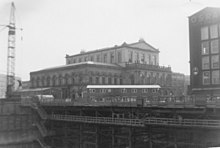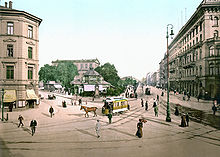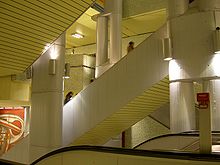Kröpcke

The Kröpcke [ ˈkʁœpkə ] is a square-like intersection in the pedestrian zone of Hanover . It is considered the most central point in the city. With the Kröpcke clock , which is traditionally used by the Hanoverians as a meeting point, one of Hanover's landmarks is on site. The two wings of Georgstraße , Bahnhofstraße , Karmarschstraße and Rathenaustraße cross at the Kröpcke . The largest station of the Hannover Stadtbahn is located underground . The Kröpcke was named after the local café.
Emergence

The intersection arose in 1843 as a transition between the old town and the path to the newly built Central train station a little further to the northeast . As a result, under the guidance of the court architect Laves, the city area expanded to the north and east to include the Ernst-August-Stadt . As can be clearly seen from old city maps , the town planning meant that the neighboring Opernplatz (then: Theaterplatz) and Ernst-August-Platz at the train station were actually intended for space functions. However, this intersection turned the action on itself in order to replace the market square near the market church as the absolute heart of the city.
In 1872 the first horse-drawn tram crossed the crossing, later replaced by the electric tram . In 1931 the first traffic lights in Hanover stood at Kröpcke . During the air raids on Hanover in World War II, the entire area - except for the Kröpcke clock - was destroyed. With the increase in car traffic, the intersection was given a traffic pulpit for the 1950s and 1960s . In the course of the underground construction work in the early 1970s, the Kröpcke and the adjacent streets were then converted into a pedestrian zone , even if trams continued to run above ground for a while. In contrast to real places, it is not possible to determine the exact area and boundaries of the Kröpcke; this is ultimately a matter of subjective judgment. You hardly ever say “on the Kröpcke”, but more commonly “on the Kröpcke”.
Buildings on the Kröpcke
Café Kröpcke
In the old town there was the long-established pastry shop of the family business Robby . In 1869 Georg Robby moved the business to the northwest corner of the Theater and Opernplatz. He opened Café Robby in a cast iron building designed by Otto Goetze , which was modeled on an oriental-style pavilion at the Paris World Exhibition in 1867 . From 1878 onwards , Wilhelm Kröpcke from Bleckede near Lüneburg worked as a waiter . After Café Robby was leased elsewhere, Wilhelm Kröpcke leased it himself from 1885 onwards. In 1895, when the building was now owned by the city, he renamed it Café Kröpcke . He ran it until his death in 1919.
With its own atmosphere, the Kröpcke café gained fame beyond Hanover. It also developed into a meeting point for various cultural or social scenes. Among other things, male prostitution took place around it, the milieu in which the serial killer Fritz Haarmann found his victims. The name of the café was popularly transferred to the intersection over time.
Then the place was officially named Kröpcke in 1948 . In the same year, after the war-related destruction, a new café was built based on a design by the architect Dieter Oesterlen . Since the operation was no longer allowed to be called Café Kröpcke after an objection by the descendants of Wilhelm Kröpcke , the name Café am Kröpcke was chosen tellingly (today, however, the label is Café Kröpcke ). As early as 1974, the building was demolished again because of the underground construction, before it was reopened two years later in the current building with the striking roof construction planned by Matthaei -Elschner / Fischer - von Bassewitz . The café has been operated by Mövenpick ever since. On the occasion of the Expo 2000 , the building received an extension for an Expo café , which is now followed by a consultation center of the Stadtwerke Hannover .
Kröpcke clock
The Kröpcke clock was originally a weather pillar designed by Konrad Oertel in 1885 . During the Second World War it was damaged by an Allied bombing raid in 1943, but it was able to be reopened in 1945. In 1954 they were replaced by a modern clock, and the same clocks were also placed on the Steintor and on Aegidientorplatz. In 1977 Werner Hoffmann made a simplified reconstruction of the historical weather pillar for the Kröpcke. Like the Ernst August monument at the main train station, the clock is a classic meeting point in Hanover .
Kröpcke Center
To the south of the intersection there was initially a municipal building that served as the Hanover Higher Trade School and then as the Hanover Polytechnic . When the school moved out and Karmarschstrasse was laid out in 1879, the Hotel Continental was built on the now acute-angled property between Georgstrasse and Karmarschstrasse . The hotel was destroyed in the air raids on Hanover in 1943. At the end of the 1940s, the two-story temporary structure called the Conti-Block followed .

That was demolished around 1970 during the construction work for the Kröpcke subway station. Instead, the up to 51 meter high Kröpcke Center was built in 1972 in the brutalist style . The main tenant of the building was initially a Wertheim department store , later it became known for the branch of the fashion house Peek & Cloppenburg that still exists today . Because of the architecture, which was soon felt to be out of date, the Kröpcke Center was for years one of the most controversial buildings in the city. However, planned modifications were repeatedly postponed.
After several changes of ownership, the Düsseldorf-based CENTRUM Grundstücksgesellschaft carried out a fundamental renovation in 2009 , during which large parts of the complex were rebuilt. The colloquial “Kröpcke-Loch” at the southern end of the Niki-de-Saint-Phalle-Promenade ( Passerelle ) in the so-called Minus-1-level was closed, the development moved forward. Since no long-term tenant could be found for the high-rise tower, it was decided, contrary to the original plan, to demolish it. The investment volume for the renovation work was around 200 million euros. Before the end of 2013, the real estate fund company Union Investment Real Estate joined as the new owner.
Development of the other three corners
Corresponding to the predominant intersection character, the buildings in the three other corners - next to the café and the Kröpcke-Center - are oriented with their fronts more towards the confluent streets than towards the center. The Europa House is in the southwest . It is the first newly constructed commercial building in the city center of Hanover, which was destroyed by the Second World War, to have historical symbolic power. The Magis House , built in the north-western corner in the early 1950s, has an architecture that was unusually sophisticated for its time and, even today, very attractive. In contrast, the development of the northeast corner, after it was still formative for Kröpcke in the 1950s and 1960s with eye-catching advertising (especially from the local coffee producer Machwitz ), has no other significance in the city.
Installation of a cloud of light

Since 2015, the Kröpcke has been illuminated at night via the artistic installation Lichtwolke . The design for this comes from the lighting designer Ulrike Brandi . The object consists of folded metal strips with 64 LED lamps attached to them. It hangs on suspension ropes which are attached to the surrounding buildings with four hooks. Commissioning was delayed by about a year because the budget could not be adhered to at first, so that the production had to be put out to tender again. In addition, the city had to negotiate for a long time with a house owner about the installation of one of the hooks. The light cloud cost around 370,000 euros to purchase, and the operating costs are around 1,000 euros per month. To avoid ice fall, the property can be heated in winter. An ultrasound device should also prevent pigeons from settling on it. Tests in the wind tunnel were used to ensure that gusts of wind could not tear the cloud of light from its anchorage.
Kröpcke underground station
The Kröpcke underground station is the most important junction of the Hanover light rail . All three tunnels intersect here. Lines 1 to 9, 11, 16, 18 and N10 run on six platforms. The station has the four longest escalators in Hanover. With a length of about 33 m each, they lead from the distribution level (-1) to the two platforms of the C-route (-4).
literature
- Gerd Weiß, Marianne Zehnpfennig: Georgstrasse. In: Monument topography of the Federal Republic of Germany . Part 1, [Vol.] 10.1: Architectural monuments in Lower Saxony, City of Hanover. Edited by Hans-Herbert Möller, ISBN 3-528-06203-7 , pp. 68f. u.ö., as well as plant center. In: List of architectural monuments according to § 4 ( NDSchG ) (excluding architectural monuments of the archaeological preservation of monuments), status July 1st, 1985. City of Hanover, Lower Saxony State Administration Office - Institute for Monument Preservation , p. 3ff.
- Helmut Knocke , Hugo Thielen : Kröpcke. In: Hannover Art and Culture Lexicon , p. 162f.
- Dirk Böttcher , Klaus Mlynek , Waldemar R. Röhrbein , Hugo Thielen (eds.): Kröpcke. In: Hannoversches Biographisches Lexikon , passim ; mostly online through google books .
- Franz Rudolf Zankl , Helmut Koch: Places in Hanover [then and now]. Theater at the kitchen garden. A comparison of historical photographs and current photographs by Harald Koch and texts by Franz Rudolf Zankl. TAK, Hannover 1998, ISBN 3-9806454-0-1 , p. 54ff.
- Martin Wörner, Ulrich Hägele, Sabine Kirchhof: Architectural Guide Hannover (= Architectural Guide to Hannover. ). With an introduction by Stefan Amt. Reimer, Berlin 2000, ISBN 3-496-01210-2 , p. 5f.
- Friedrich Lindau : Hanover. Reconstruction and destruction. The city in dealing with its architectural identity. Schlütersche, Hannover 2001 (2nd edition), ISBN 3-87706-607-0 , pp. 35ff., 38ff .; partly online via Google books .
- Friedrich Lindau: Planning and building in the fifties in Hanover. Schlueter, Hannover 1998, ISBN 3-87706-530-9 , passim; partly online via Google books
- Klaus Mlynek, Waldemar R. Röhrbein (ed.): History of the city of Hanover . Volume 2: From the beginning of the 19th century to the present. Schlueter, Hannover 1994, ISBN 3-87706-364-0 , passim; mostly online via Google books .
- Klaus Mlynek, Waldemar R. Röhrbein: Hanover Chronicle . From the beginning to the present: numbers, data, facts. Schlueter, Hannover 1991, ISBN 3-87706-319-5 , passim; partly online via Google books .
- Ludwig Zerull : Art without a roof. Sculptures and objects in the cityscape of Hanover (= Edition Libri Artis. ). Schäfer, Hannover 1992, ISBN 3-88746-278-5 , p. 65.
- Eva Benz-Rababah : Kröpcke. In: Klaus Mlynek, Waldemar R. Röhrbein (eds.) U. a .: City Lexicon Hanover . From the beginning to the present. Schlütersche, Hannover 2009, ISBN 978-3-89993-662-9 , p. 371f.
- Olaf Gisbertz : The Kröpcke Center. In: ModerneREGIONAL. Born in 2014, No. 2.
- Britta Krüger ( editor ), Thomas Parr (collaborator): 150 years of Café Kröpcke , Festschrift, publisher: Café am Kröpcke Betriebsgesellschaft mbH & Co. KG, Isernhagen: Hahnsche Buchhandlung Verlagsgesellschaft mbH, 2019
Web links
- Information about the historical clock
- Interactive 360 ° panorama photo of the square - above ground
- Interactive 360 ° panorama photo of the Kröpcke subway station - underground
- The Kröpcke through the ages , HAZ photo series
- Historical recordings of the Kröpcke
- Description of the place at Hannover.de
Individual evidence
- ↑ Klaus Mlynek: Hanover Chronicle: From the beginnings to the present . ISBN 3-87706-319-5
- ^ Helmut Zimmermann: Hanover in your pocket. Buildings and monuments from AZ . H. Feesche Verlag Hannover 1983, p. 55
- ↑ Projekt Kröpcke ( Memento of the original from October 18, 2011 in the Internet Archive ) Info: The archive link was automatically inserted and not yet checked. Please check the original and archive link according to the instructions and then remove this notice. , leinekunst.de, accessed on April 16, 2011
- ↑ Joachim Holtz: Zeitliches from Hanover: Heart made of concrete , Die Zeit , January 6, 1978
- ^ Hanover from 1967 to 1983 , hannover.de
- ↑ CENTRUM Grundstücksgesellschaft mbH: Start of construction for the Kröpcke Center in Hanover (PDF file; 73 kB), accessed on April 14, 2011
- ↑ HAZ: The renovation of the Kröpcke Center must be finished by 2013 , accessed on April 14, 2011
- ↑ Completion 2014: Union Investment buys Kröpcke-Center. Press release. In: Hannover.de , accessed on December 3, 2015.
- ↑ The light goes on for Kröpcke. In: HAZ.de , October 12, 2015. Accessed October 16, 2015.
- ↑ a b The Kröpcke sun only shines in 2015. In: HAZ.de , October 21, 2014. Accessed on October 16, 2015.
- ↑ a b Installation of the light cloud is delayed again. In: HAZ.de , August 22, 2015. Retrieved October 16, 2015.
Coordinates: 52 ° 22 ′ 28 ″ N , 9 ° 44 ′ 19 ″ E




